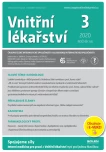The first cases of genetically confirmed congenital diarrhea with chloride loss in Slovakia
Authors:
Udmila Podracká; Mária Chocholová
Authors‘ workplace:
Detská klinika LF UK a Národného ústavu detských chorôb Bratislava, Slovenská republika
Published in:
Vnitř Lék 2020; 66(3): 186-189
Category:
Case Report
Overview
Chloride ions are involved in regulating cell volume, secreting body fluids and maintaining acid-base balance. Hypo/hyperchloraemia in neonates and infants is an emergent situation requiring careful differential diagnosis to detect a cause of the condition. The rare causes of severe hypochloremia include congenital chloridorhea (CLD), characterized by profound bulky diarrhea, high chloride concentration in stool, and severe metabolic alkalosis. CLD is a rare autosomal recessive disease caused by the mutation of the SLC26A3 gene located on chromosome 7q31, which encodes the transmembrane protein in intestinal cells. Genetic defect causes a disorder of intestinal chloride absorption and bicarbonate secretion. Profound diarrhea induces significant losses of water and electrolytes, leading to volume depletion, hyperreninemia, hyperaldosteronism, renal loss of potassium and occasionally to the development of chronic nephropathy. The authors present rare cases of two brothers with genetically confirmed CLD. Both children were born with lower birth weight and shortly after birth required administration to ICU because of notable distended abdomen and diarrhea with severe dehydration and electrolyte imbalance. Significant hypochloraemia (76 mmol/l or 78 mmol/l) and extreme metabolic alkalosis (pH 7.63; HCO3 46 mmol/l and pH 7.73; HCO3 40 mmol/l resp.) were dominant laboratory features. Renal chloride losses and cystic fibrosis were excluded; the chloride concentration test in stool was not available. After intravenous suplementation of electrolytes, the biochemical abnormalities were partially normalized and watery stools persist. In further development, the frequent episodes of dehydratation reguiring the parenteral treatment were present. Renal functions are at age 6 or 2 years resp. normal, but USG signs of nephrocalcinosis in the older boy have been observed. By molecular genetic testing the same genotype in both siblings was identified the previously not described variant c.629_63Ildel (p.Ile210del) and the pathogenic variant in the heterozygous state of the SLC26A3 gene. In persistent watery diarrhea, hypochloraemia, hypokalaemia and metabolic alkalosis, a congenital chloridorhea should be consider. The diagnosis is based on a typical clinical picture of watery diarrhea from neonatal age, evidence of a high chloride concentration in stool > 90 mmol/l and molecular-genetic examination. CLD patients require regular nephrologic monitoring for the risk of chronic nephropathy or functional tubular damage.
Keywords:
alkalosis – congenital chloride diarrhea – hypochloremia
Sources
1. Darrow DC Congenital alkalosis with diarrhoea. J Pediatr 1945; 426: 519–532.
2. Gamble JL, Fahey KR, Appleton J et al. Congenital alkalosis with diarrhoea. J Pediatr 1945; 26: 509–518.
3. Perheentupa J, Eklund J, Kojo N Familial chloride diarrhoea („congenital alkalosis with diarrhoea“). Acta Paediatr Scand 1965; 159: (Suppl.): 119–120.
4. Launiala K, Perheentupa J, Pasternack A et al. Familial chloride diarrhea-chloride malabsorption. Bibl Paediatr 1968; 87: 137–149.
5. Li WC, Shih HH, Wu KL et al. Congenital chloride diarrhea in a child. J Formos Med Assoc 2003; 102: 424–428.
6. Wedenoja S, Ormälä T, Berg UB et al. The impact of sodium chloride and volume depletion in the chronic kidney disease of congenital chloride diarrhea. Kidney Int. 2008; 74: 1085–1093.
7. Höglund P, Auranen M, Socha J et al. Genetic background of congenital chloride diarrhea in high‑incidence populations: Finland, Poland, and Saudi Arabia and Kuwait. Am J Hum Genet 1998; 63: 760–768.
8. Höglund P, Haila S, Socha J et al. Mutations of the down‑regulated in adenoma (DRA) gene cause congenital chloride diarrhoea. Nat Genet 1996; 14: 316–319.
9. Moseley RH, Höglund P, Wu GD et al. Downregulated in adenoma gene encodes a chloride transporter defective in congenital chloride diarrhea. Am J Physiol 1999; 276: G 185–G192.
10. Schweinfest CW, Spyropoulos DD, Henderson KW et al. slc26a3(dra)-deficient mice display chloride‑losing diarrhea, enhanced colonic proliferation, and distinct up‑regulation of ion transporters in the colon. J Biol Chem 2006; 281: 37962–37971.
11. Wedenoja S, Pekansaari E, Höglund P et al. Update on SLC26A3 mutations in congenital chloride diarrhea. Hum Mutat 2011; 32: 715–722.
12. Höglund P, Holmberg C, Sherman P et al. Distinct outcomes of chloride diarrhoea in two siblings with identical genetic back‑ground of the disease: implications for early diagnosis and treatment. Gut 2001; 48: 724–727.
13. Hong J, Seo JK, Ko JS et al. Congenital chloride diarrhea in Korean children: novel mutations and genetic characteristics. Eur J Pediatr 2013; 172: 545–550.
14. Turnberg LA. Abnormalities in intestinal electrolyte transport in congenital chloridorrhoea. Gut 1971; 12: 544–551
15. Hayashi H, Suruga K, Yamashita Y Regulation of intestinal Cl-/HCO3-exchanger SLC26A3 by intracellular pH. Am J Physiol Cell Physiol 2009; 296: C1279–C1290.
16. Holmberg C, Perheentupa J, Launiala K et al. Congenital chloride diarrhoea. Clinical analysis of 21 Finnish patients. Arch Dis Child 1977; 52: 255–267.
17. Hihnala S, Kujala M, Toppari J et al. Expression of SLC26A3, CFTR and NHE3 in the human male reproductive tract: role in male subfertility caused by congenital chloride diarrhoea. Mol Hum Reprod 2006; 12: 107–111.
18. Wedenoja S, Höglund P, Holmberg C Review article: the clinical management of congenital chloride diarrhoea. Aliment Pharmacol Ther 2010; 31: 47–485.
19. Gils C, Eckhardt MC, Nielsen PE et al. Congenital chloride diarrhea: Diagnosis by easy accessible chloride measurement in feces. Case reports in Pediatrics 2016; 2519498: 3 pages. http://dx.doi.org/10.1155/2016/2519498.
Labels
Diabetology Endocrinology Internal medicineArticle was published in
Internal Medicine

2020 Issue 3
Most read in this issue
- Local thrombolysis for deep vein thrombosis: why, for whom and how?
- What is hiden behind autoinflammation?
- Proteinuria from an internist‘s point of view
- Hepatorenal syndrome – update 2020
